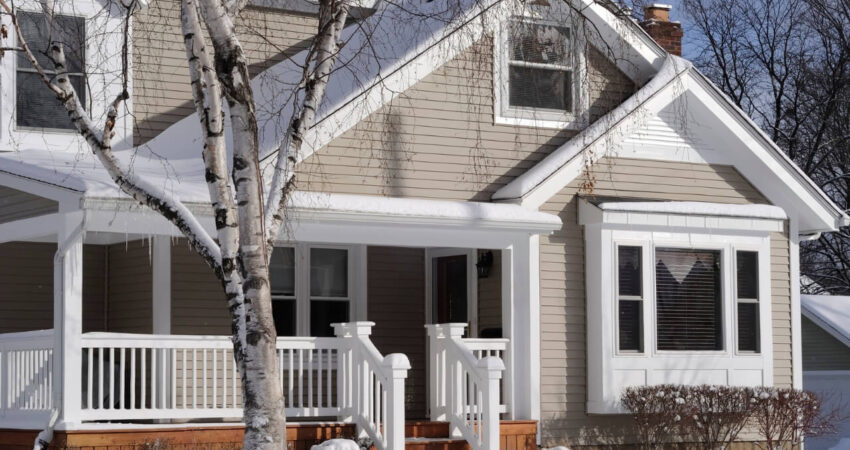Winter can be a challenging time for homeowners and property managers, especially when it comes to maintaining shingle roofs. Snow, ice, and freezing temperatures can exacerbate existing issues and create new problems that compromise the integrity of your roof. This guide explores common winter problems for shingle roofs and offers practical solutions from Tier-1 Roofing and Exteriors, a trusted Roofing Company in Dayton.
1. Ice Dams: A Silent Roof Killer
Ice dams occur when warm air from your home melts snow on the roof. As the water flows down, it refreezes at the colder edges, creating a dam. This leads to water backing up under the shingles, causing leaks.
How to Address Ice Dams:
- Insulation: Proper attic insulation minimizes heat loss.
- Ventilation: Ensure your roof has adequate ventilation to regulate temperature.
- Heated Cables: Install heated cables along the roof’s edge to melt ice and prevent buildup.
2. Snow Load Stress
Excessive snow accumulation can stress your roof, leading to sagging or, in extreme cases, collapse.
How to Address Snow Load Stress:
- Snow Removal: Use a roof rake with a long handle to safely remove snow.
- Structural Inspection: Hire a Roofer in your area like Tier-1 Roofing and Exteriors to assess your roof’s load-bearing capacity.
3. Shingle Damage from Freeze-Thaw Cycles
Repeated freezing and thawing can loosen shingles, leading to water seepage and reduced durability.
How to Address Shingle Damage:
- Regular Inspections: Schedule a winter inspection with experts in Commercial Roofing to identify potential issues.
- Timely Repairs: Replace damaged shingles promptly to prevent further damage.
4. Gutter Clogs and Overflow
Falling leaves and snow can clog gutters, causing water to back up onto your roof and freeze.
How to Address Gutter Clogs:
- Gutter Guards: Install guards to keep debris out.
- Routine Cleaning: Clear gutters before winter arrives.
- Downspout Extensions: Ensure downspouts direct water far from your property.
5. Condensation in Attics
Condensation forms when warm indoor air meets the cold roof deck, leading to moisture buildup, mold, and rot.
How to Address Condensation:
- Seal Leaks: Seal air leaks to prevent warm air from escaping into the attic.
- Improved Ventilation: Ensure a balanced ventilation system for proper airflow.
6. Flashing Failures
Flashing seals roof penetrations, like chimneys and vents. Winter conditions can cause it to crack or pull away.
How to Address Flashing Issues:
- Inspection: Check flashing regularly or hire experts in TPO Roofing and EPDM Roofing for a detailed assessment.
- Professional Repairs: Work with Tier-1 Roofing and Exteriors for prompt flashing repairs.
7. Leaks Due to Melting Snow
Melting snow can seep through cracks and weak spots in the roof.
How to Address Snow-Related Leaks:
- Emergency Repairs: Call a reliable Roofing Company in Dayton for immediate assistance.
- Preventive Maintenance: Invest in quality materials like Metal Roofing for added durability.
8. Popped Nails and Loose Shingles
Fluctuating temperatures can cause nails to pop, loosening shingles and creating potential leak points.
How to Address Popped Nails:
- Routine Checks: Inspect your roof regularly for popped nails.
- Secure Fasteners: Replace loose or missing nails with longer, corrosion-resistant options.
9. Wind Damage
Winter storms bring high winds, which can lift or tear shingles.
How to Address Wind Damage:
- Roof Anchoring: Secure shingles with high-quality fasteners.
- Reinforcements: Contact Tier-1 Roofing and Exteriors for storm-resistant solutions.
10. Aging Shingles
Older shingles may crack or lose granules, making them vulnerable to winter conditions.
How to Address Aging Shingles:
- Roof Replacement: Consider upgrading to durable options like TPO Roofing, EPDM Roofing, or Metal Roofing.
- Seasonal Maintenance: Schedule biannual roof checkups to prolong lifespan.
Why Choose Tier-1 Roofing and Exteriors?
As a leading Roofing Company in Dayton, Tier-1 Roofing and Exteriors offers specialized services in residential and Commercial Roofing, TPO Roofing, EPDM Roofing, and Metal Roofing. Their team of experts ensures your roof remains in excellent condition throughout winter and beyond.
FAQs
1. How often should I inspect my shingle roof in winter?
Inspect your roof at least twice during winter: once after the first snowfall and again in late winter.
2. Can snow removal damage my roof?
Using improper tools can damage shingles. Opt for a roof rake or hire professionals.
3. What is the lifespan of shingle roofs?
Typically, shingle roofs last 20–30 years with proper maintenance.
4. Are metal roofs better for winter?
Yes, Metal Roofing is highly durable, resistant to snow buildup, and requires minimal maintenance.
5. How can I prevent ice dams on a low-slope roof?
Install heat cables, improve attic insulation, and ensure proper drainage.
6. Is TPO or EPDM better for commercial roofing in winter?
Both materials perform well, but TPO is more reflective and energy-efficient, making it ideal for winter.
